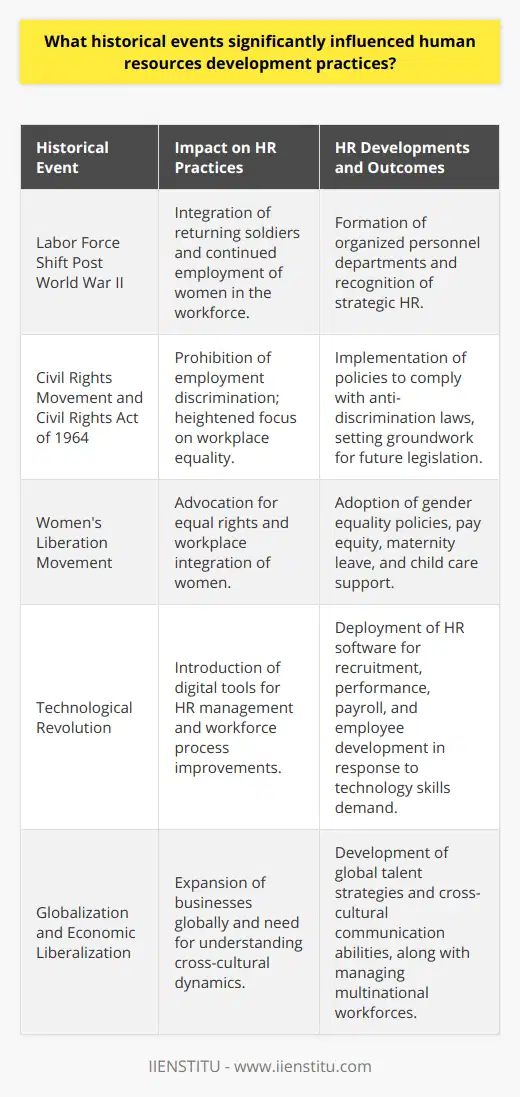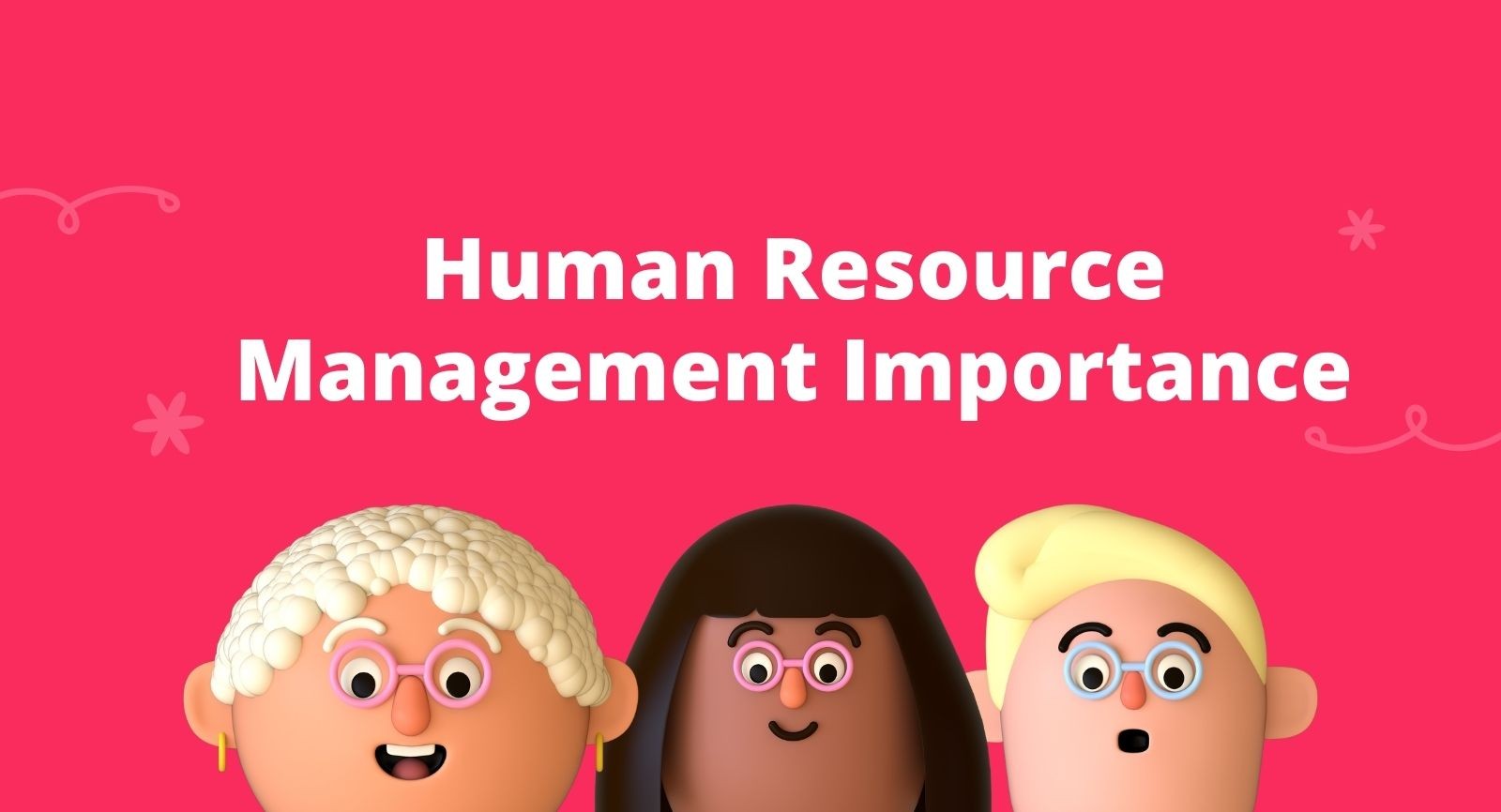
The history of human resources development is long and complex, but it all starts with one man. More than two thousand years ago in ancient Greece, Aristotle developed the concept that would eventually give us modern-day HR. An acronym for Human Resources or sometimes just referred to as personnel department within a business firm which deals specifically with managing its employees' benefits packages among other things related to it such jobs can include matters concerning sick leave usage rights. We will handle the development of human resources from 1900 to the current application in detail.
Human Resources Development in the Early 1900s
The Board of Education Act (1906) put other education institutions under the board's jurisdiction. This was also a time when self-help organizations – which provided instruction for apprentices – became more popular and widespread; many of these were run by well-meaning citizens who would not only train their students but also give them a stipend to offset their living expenses.
In 1907, the Technical Education Inquiry Commission recommended developing a curriculum for trade and technical instruction. Before this time, there was no standardization in training provision across various educational institutions; some companies even used their training manuals written in-house! In 1908, an advisory committee on trade and technical education was established to create the (British) Board of Education's Trade and Technical Education Committee; this committee was tasked with creating standard courses in six technology-related subjects.
By 1913, small classes became more common in industrial training institutions; there were even instances when these included women! This is because industrial training programs depend on the input of tutors who had gone through similar experiences as their students at some point in their lives; this allowed their teaching methods to be more relatable and effective.
By this time, companies were able to cover more than half of an apprentice's salary during training; they were also given tools and materials that they could use to practice their newly acquired skills upon the completion of their training. Although there was tension between employers, employees, and trade unions at first regarding these apprenticeships, their benefits eventually became evident; this led to the acceptance of apprenticeships during this time as it allowed workers to learn more advanced techniques in the workplace.
The earliest record of trade education's existence was in Germany. It consisted of apprentice programs for teens who served as full-time employees during their four years of apprenticeship training. These programs were paid, and the young apprentices were given both food and lodging; however, they had to spend half of their waking hours attending classes.
In Norway, twenty vocational schools provided trades like carpentry, upholstery, auto mechanics, building construction (including bricklaying), electrical work, smithing (including blacksmithing), and watchmaking.
In Sweden, trade education was offered to apprentices who were typically 14 years of age when they enrolled in their coursework; boys remained in this program for 5-7 years while girls stayed for 4-5 years. Generally speaking, courses were taught by experts in the field who had experience working in industrial settings.
The earliest trade college in Australia was founded in Launceston; it was called the Central Trade College and offered training to students in several areas like carpentry, bricklaying (for masons), plumbing, smithing (including blacksmithing), gas-fitting, metalwork, and electrical wiring.
The Role of Human Resources Development Professionals in the 1940s -1960s
During World War II, human resources professionals (HR) were an integral part of the workforce. As part of the mobilization that occurred before and during WWII, HR's assisted in supporting soldiers and sailors at home while also working with recruiters overseas to put them into uniforms for their country's needs abroad.
During this era, there seemed no limit on what human resources could accomplish, from providing food supplies that would last through winter months without having any perish due to shortage-related deaths to building weapons systems like tanks that took over strategic positions across European troops free movement.
HR professionals were involved in transportation and relocation, morale on the job or leave, handling special requests or grievances, and receiving records of service or personal history. They also assisted in finding temporary jobs for returning war veterans to ease the transition back into civilian life.
After the war, US HR professionals continued to be involved in transportation and relocation, morale on the job or leave, handling special requests or grievances, and receiving records of service or personal history. They also assisted in finding temporary jobs for returning war veterans to ease the transition back into civilian life. Today's HR professionals must consider any legal mandates required to comply with US law, such as federal employment laws, which employers are bound to follow.
During WWII, when US citizens asked so much, HR professionals took over many functions that governmental agencies would usually do at other times. They addressed the everyday needs of the workforce, such as managing leave for employees, granting sick pay when necessary, and inquiring about family health.
As more women entered the workforce, HR had to address hiring and promoting females. They also oversaw layoffs and terminations and training managers on how to supervise female workers. With such a high percentage of soldiers overseas at this time, companies were bracing themselves for future labor shortages as well. HR professionals had to prepare themselves to manage labor during a crisis, which meant planning for these gaps and not over-hiring or over-promoting.
Finally, they must know about the productivity of their department and how it can be improved. During World War II, these things were happening in HR because companies needed them to get through this crisis period efficiently and productively.
Even though HR professionals in the 1940s-1960s had to take on much responsibility during this time, it was not until after World War II that they started to get more recognition for their efforts. When soldiers returned home from serving overseas, many were reskilled to continue working in their previous occupation or find a new one.
In order to help veterans with their transition from military life back into civilian life, the GI Bill was created in 1944. This bill provided financial support for education and training for those who had left high school before graduating or entering college for the first time. In addition to providing vocational courses and educational opportunities, HR professionals helped businesses rebuild themselves.
As a result of many women entering the workforce during the war, companies were not used to having so many females in their workplace. With this new influx of workers, HR professionals had to work harder to manage relationships, maintain morale, and improve employee relations. In addition, they tackled issues such as sexual harassment and equal pay for equal work, both of which are still being discussed today.
One major accomplishment for HR professionals was the introduction of an internal training program within an organization that would be aimed at managers and supervisors. These courses were designed to help workers be more productive while keeping morale high and job satisfaction consistent. This laid the groundwork for what today's HR professionals are expected to do within their organizations.
Changes to Human Resources Development Programs and Curricula from the 1970s - 2000s
Since the early 1970s, there have been many changes in HRD programs and curricula. In particular:
- Increased integration of education with work experiences to prepare people for careers outside teaching
- Increased use of cooperative learning strategies that promote collaboration among students instead of individualism
- More emphasis on student-centered activities such as service projects which aid them to gain life skills beyond academics while still being engaged academically.
- Decreased use of lectures and increased use of group work
- Emphasis on learning theories that are more closely tied to the role/skill performance rather than the traditional focus on attitudinal change
- Increased use of technology-based training; increased use of internships in which students work in actual organizations that provide hands-on experience related to their field of study
- Increased opportunities for students to take courses outside their discipline
- Increased emphasis on experiential learning through peer review activities, capstone projects, and research.
- Increased emphasis on analysis, synthesis, and evaluation skills rather than rote learning.
- Increased emphasis on using technology to enhance learning via telecommunication technologies such as video-conferencing, electronic mail (e-mail), computer conferencing, etc.
- Increased interest in using "paper-and-pencil" tests that represent a shift away from technology-based training toward traditional classroom instruction; increased attention to e-learning.
Current Trends in Human Resource Development Education
Programs have evolved to help businesses cope with new developments in technology, and many of these have been formed to promote a tech-savvy workforce.
Companies are also investing in professional development courses that teach analytics techniques to their employees, which can then be applied across other business functions.
These specializations are also being adopted at the undergraduate level, with many universities offering specialized degrees in subjects like business intelligence, human-computer interaction, and information security.
HRD courses worldwide have grown exponentially over the past few years due to the increasing demand for digital skills.
If you want to work Human Resources Development area, you can attend the Human Resources Development Course at IIENSTITU. Learn more about current trends and gain more skills for work in this area. Also, this is important for getting awareness.

The history of human resources development spans back to the time of Aristotle and has greatly evolved over the years. Throughout the 1900s, HR started to play a more substantial role as vocational and trade schools began to rise, providing technical and practical skill learning through apprenticeship programs. By the 1940s and 1960s, HR professionals were vital in maintaining workforce morale, easing transition into civilian life for war veterans and handling grievances. Looking at this progression, the shift towards online learning platforms can also be seen as a significant development in HR training. This has made it possible to attend HR classes online, a strategy that continues to shape the future of human resources development.hr classes online
Frequently Asked Questions
What is the historical breakthrough of human resource management?
Historical Breakthrough of HRM
The historical breakthrough of human resource management (HRM) occurred during the Industrial Revolution in the late 19th and early 20th centuries when organizations began to recognize the importance of the workforce for business success. Prior to this period, labor was primarily viewed as a commodity, and workers were often replaced with no attention given to their well-being or development.
Shift in Perspective
The rise of labor unions in the 1930s and the Hawthorne Experiments conducted by Elton Mayo in the 1920s and 1930s led to the realization that employee satisfaction and motivation directly influenced productivity. This sparked a shift in perspective where organizations began to treat their employees as valuable resources instead of mere interchangeable components.
Personnel Management Emerges
During the 1940s and 1950s, the field of personnel management emerged, focusing on recruitment, training, and employee relations. This laid the foundation of modern HRM, recognizing the need to manage workforce diversity, follow labor laws, and implement employee benefits to maintain a competitive edge in the market.
Emergence of HRM as a Strategic Role
The 1970s and 1980s saw further developments, with HRM becoming a strategic function within organizations. The focus shifted from purely administrative tasks to aligning human resource practices with business goals. HR professionals began emphasizing workforce planning, talent management, and organizational development to create a sustainable competitive advantage.
Technological Advancements
The advent of the internet and digital technology in the 1990s and early 2000s dramatically transformed HRM practices. The automation of routine tasks, development of HR information systems, and use of data analytics allowed HR professionals to optimize processes, improve decision-making, and foster increased collaboration and communication within organizations.
Contemporary HRM
Today, HRM is a critical aspect of any organization's success, with its scope expanding to include employee engagement, performance management, diversity and inclusion, and corporate social responsibility. The historical breakthrough of human resource management demonstrates its evolution; from solely focusing on workforce administration to playing a strategic role in the ongoing development and success of an organization.

What contributed to the evolution of human resources development?
Significance of Societal Factors
A key factor that contributed to the evolution of human resources development is the changing societal context. Advances in technology, communication, and globalization have transformed the way societies operate and interact with each other. As a result, businesses and organizations have had to adapt their human resources strategies to accommodate these changes.
Shift in Economic Conditions
Another significant contributor to the evolution of human resources development is the fluctuation in economic conditions. During periods of economic growth, organizations tend to invest more in employee training and development, recognizing the importance of a skilled workforce in driving business success. Conversely, during economic downturns, businesses often focus on cost-cutting measures, including reducing human resources investments. This constant shift in economic climates has demanded organizations to continuously adapt and reassess their human resources practices.
Changing Workforce Dynamics
The evolution of human resources development is also driven by the changing dynamics of the workforce. The increased diversity of worker backgrounds, ages, skill levels, and education has required organizations to develop tailored approaches to managing and developing their employees. Understanding the unique needs and preferences of various employee groups is critical to crafting effective human resources strategies and retaining a skilled and motivated workforce.
Rise of the Knowledge Economy
Human resources development has evolved in response to the rise of the knowledge economy. The knowledge economy emphasizes the importance of information and knowledge acquisition in driving business success, thereby placing a higher need for organizations to invest in employee training and development. As employees continuously acquire and engage with new knowledge, organizations can remain competitive in an increasingly globalized and knowledge-driven marketplace.
Increased Focus on Employee Engagement
Lastly, the increased focus on employee engagement has contributed to the evolution of human resources development. Research has demonstrated that employee engagement plays a critical role in organizational performance, leading to a greater emphasis on developing and sustaining higher levels of employee satisfaction, commitment, and motivation. To improve engagement, organizations have implemented various human resources initiatives, such as offering opportunities for career advancement and personal growth, fostering supportive work environments, and providing adequate compensation and benefits.
In conclusion, the evolution of human resources development has been shaped by numerous factors, including societal changes, fluctuations in economic conditions, workforce dynamics, the rise of the knowledge economy, and an increased focus on employee engagement. These factors have demanded organizations to adapt and continuously reassess their human resources practices, ultimately resulting in the development of more effective and comprehensive strategies for managing and supporting their workforce.
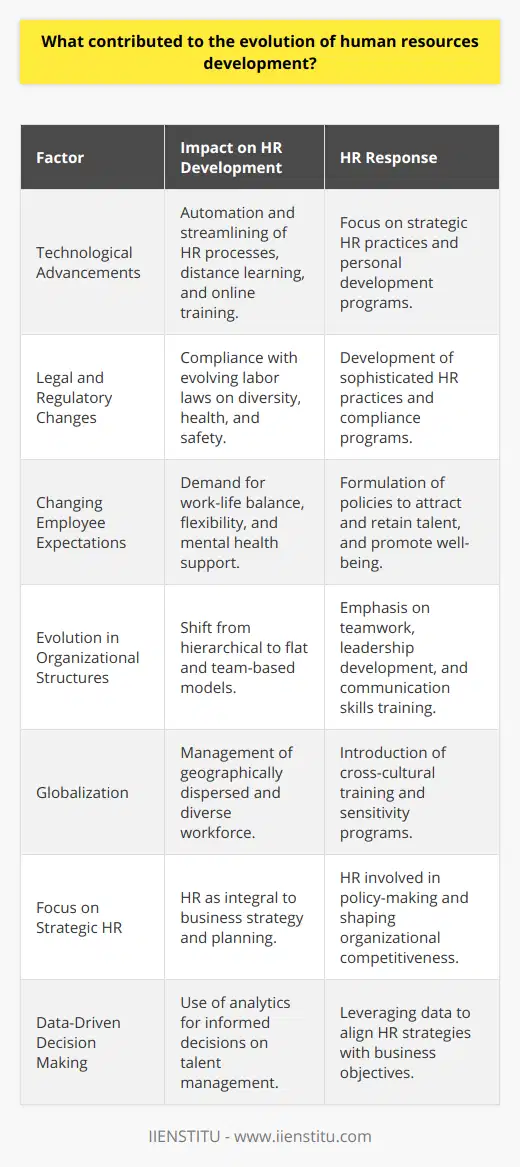
What is human resources development concept?
Concept of Human Resources Development
Human resources development (HRD) is a strategic approach to enhance the knowledge, skills, and abilities of individuals within an organization. It encompasses a wide range of activities, from training and education to career development and organizational growth.
Role of Learning and Training
In HRD, learning and training play a crucial role, as they enable employees to acquire new skills and competencies. By promoting a learning culture, organizations can foster innovation, improve performance, and adapt to changing market conditions.
Career Development
Career development is another essential component of HRD. It focuses on providing employees with opportunities for growth and advancement within the organization. Effective career development programs not only benefit employees but also contribute to the overall success of the organization by ensuring a talented and skilled workforce.
Organizational Development
Finally, HRD addresses organizational development to facilitate change and improve overall efficiency. This involves implementing strategies to enhance communication, teamwork, and leadership at all levels of the organization. Organizational development initiatives contribute to a positive work environment, thereby improving employee engagement and retention.
Outcome of HRD
In conclusion, the human resources development concept promotes a well-rounded and skilled workforce, leading to higher productivity and competitive advantage for organizations. By focusing on learning and training, career development, and organizational development, HRD aims to create a sustainable talent pipeline, supporting the long-term success of the organization.
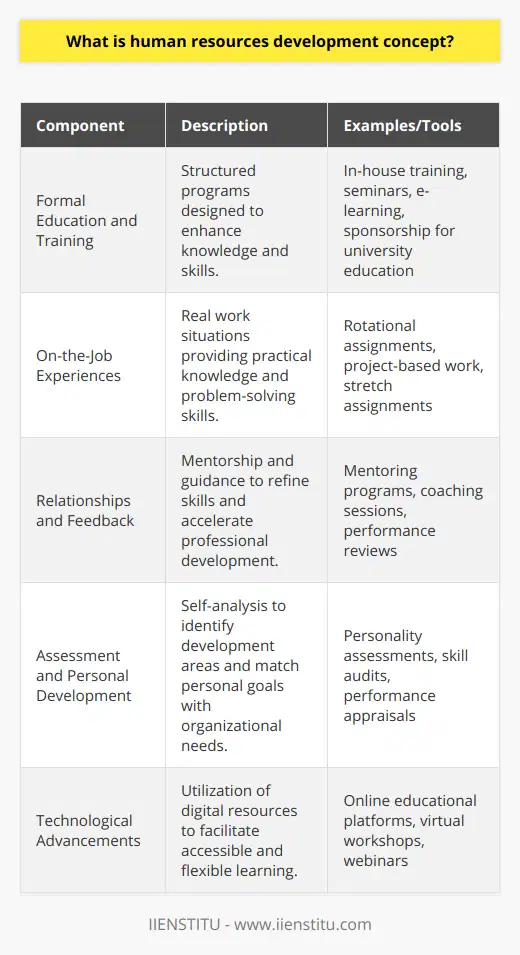
What are the key milestones in the history of human resources development?
Overview of Human Resources Development Milestones
Historical Roots and Beginnings
Human resources development (HRD) has undergone significant transformations, with its roots traced back to the industrial revolution in the late 1700s. This period witnessed several infrastructural advances, which subsequently led to increased productivity and the division of labor. Subsequently, the early 1900s experienced the emergence of scientific management, as proposed by Frederick Winslow Taylor, who emphasized the efficient allocation of tasks to workers based on their abilities.
Hawthorne Studies and The Human Relations Movement
In the 1920s and 1930s, the Hawthorne Studies, conducted by Elton Mayo, revealed that employee performance was not only dictated by the work environment, but also by social and psychological factors. These findings further reinforced the need to consider employees' welfare and motivation, giving rise to the Human Relations Movement in the mid-1900s. During this era, management practices increasingly emphasized employee communication, morale, and job satisfaction as crucial elements for fostering productivity and retention.
Post-World War II Developments
In the aftermath of World War II, the focus shifted towards welfare and better working conditions, primarily through the establishment of labor unions. This period also gave rise to the field of organizational psychology, which was instrumental in promoting better work-life balance and job enrichment, among other factors.
Civil Rights Movement and Equal Employment Opportunity
In the 1960s, the Civil Rights Movement prompted several legislative changes, including the Civil Rights Act of 1964, which prohibited employment discrimination on the basis of race, color, religion, gender, or national origin. Consequently, the Equal Employment Opportunity Commission (EEOC) was established to ensure compliance with these policies, marking a significant milestone in the history of human resources development by advocating for equal opportunities and fairness in the workplace.
Technology and Globalization
With the increasing trend of globalization and advancements in technology during the late 20th century, HRD evolved to accommodate shifting priorities and broader geographic scopes. This era witnessed the emergence of Human Resources Information Systems (HRIS), allowing for automation and streamlining of HR processes. Moreover, globalization facilitated greater cultural diversity in the workplace, necessitating HR managers to adapt their strategies accordingly.
Conclusion
Overall, the history of human resources development has been punctuated by several key milestones, including the industrial revolution, the Human Relations Movement, post-World War II developments, equal employment opportunities, and the impact of technology and globalization. These pivotal events have shaped and transformed HRD, making it more sophisticated, inclusive, and responsive to the needs of organizations and employees alike.
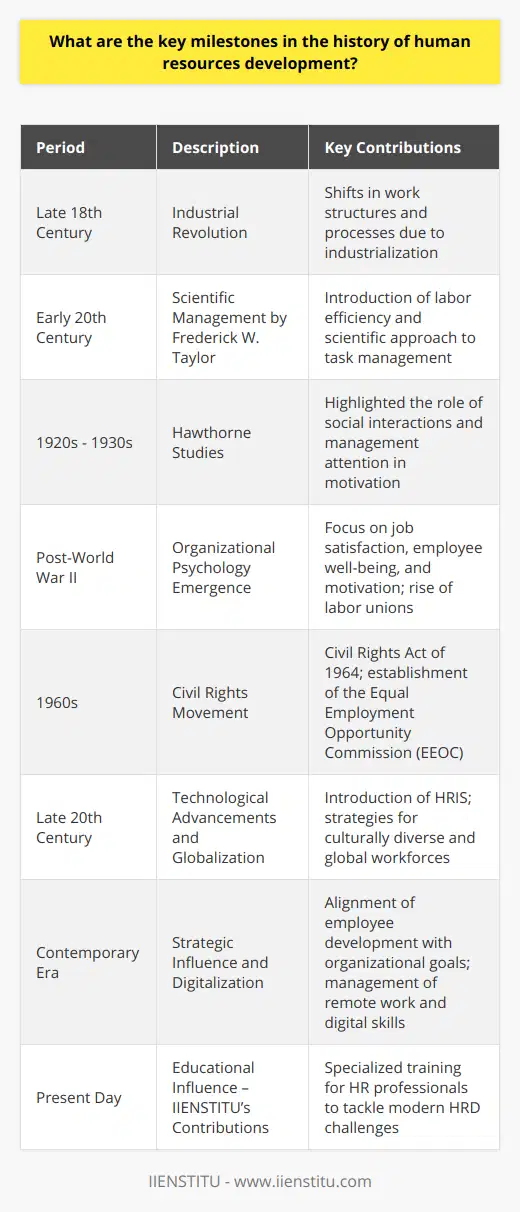
How has the role of human resources evolved over time?
Evolution of Human Resources
Historically, human resources function was primarily administrative, focused on maintaining personnel records and ensuring compliance with laws and regulations. It has undergone significant transformation and has evolved into a strategic business partner, essential for organizational success and growth. In this paragraph, we will explore key changes in the human resources function and their impact on modern organizations.
Shift from Personnel Management to Strategic HRM
One major change in HR is the transition from personnel management to strategic human resource management (HRM). Personnel management was mainly transactional, dealing with employee-related tasks such as payroll, benefits administration, and record-keeping. Strategic HRM, on the other hand, involves aligning HR practices with organizational goals and creating value by attracting, developing, and retaining skilled employees.
Emphasis on Talent Management
Another evolutionary milestone for HR is the increased importance of talent management. Organizations began to realize that their competitive advantage depended on human capital and not just financial and physical resources. Consequently, HR has been tasked with identifying, recruiting, and retaining top talent, which involves managing the entire employee lifecycle - from attraction and onboarding to career development, performance management, and succession planning.
Focus on Organizational Culture
As organizations compete for top talent, they acknowledge that a positive organizational culture plays a crucial role in attracting and retaining employees. HR professionals now work collaboratively with leaders and employees to develop an engaging work environment that promotes teamwork, innovation, and respect. They also act as culture ambassadors, helping to communicate and reinforce organizational values and expectations.
Adoption of Technology
The integration of technology into HR practices has significantly changed its role in an organization. HR professionals now use diverse technology tools to streamline processes, optimize decision-making, and enhance employee experiences. The emergence of cloud-based HR systems, data analytics, and automation has enabled HR to be more efficient in managing workforce data and generating insights for informed decision-making.
Commitment to Diversity and Inclusion
In today's globalized world, there is greater awareness of the importance of diversity and inclusion in the workplace. HR now plays an active role in championing initiatives to ensure that organizations create an inclusive environment where everyone's voice is heard and valued. This involves developing policies, building robust governance structures, and implementing training and awareness programs to foster a diverse and inclusive culture.
In conclusion, the role of human resources has significantly evolved over time, moving from a mere record-keeping function to a strategic business partner. Its broadened scope now focuses on talent management, organizational culture, technology adoption, and diversity and inclusion, making it an indispensable force in driving organizational success.
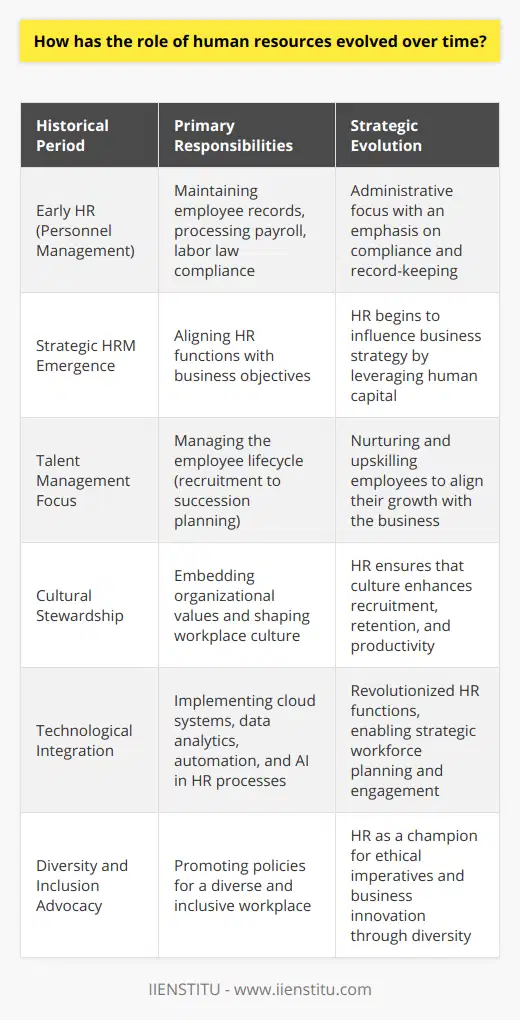
What are some major influences in the progression of human resources development?
Major Influences in HRD Progression
Organizational Goals and Objectives
The progression of human resources development (HRD) is significantly influenced by an organization's goals and objectives. Companies striving for growth, expansion, or innovation require a workforce that is equipped with the necessary skills and knowledge to drive these objectives forward. HRD professionals play a crucial role in aligning training, development, and performance management initiatives according to the organization's strategic vision, thereby shaping its long-term success.
Technological Advancements
Technological advancements have reshaped the way HRD operates. The proliferation of digital tools and platforms such as learning management systems, online training resources, and data-driven performance analytics has enabled HRD professionals to streamline their processes, enhance the learning experience, and foster a culture of continuous growth within the organization. Embracing technology has also resulted in a shift towards more personalized, just-in-time, and self-directed learning opportunities for employees, which have proven to be more effective in improving performance.
Globalization
As businesses expand their global reach, employees are increasingly expected to work and collaborate across international boundaries. This necessitates the development of a culturally diverse workforce equipped with the capabilities to navigate the complexities of the global marketplace effectively. As a result, HRD specialists must adapt their strategies by incorporating multicultural training, language courses, and cross-cultural communication skills in their programs to ensure employees are prepared for the challenges of working in a globalized economy.
Legislation and Compliance
Complying with national and international legal and regulatory frameworks is essential in the progression of HRD. Legal standards such as the Fair Labor Standards Act and the Occupational Safety and Health Act establish guidelines for employee rights and workplace safety, shaping HRD initiatives accordingly. Furthermore, regulations pertaining to diversity, equity, and inclusion require organizations to develop and maintain comprehensive policies and procedures that foster a supportive and inclusive environment for employee growth and development.
Workforce Demographics
Finally, the changing demographics of the workforce play a critical role in the progression of HRD. As the workforce ages and becomes more diverse, HRD practitioners must enable employees to adapt to change and transition across various career stages. This includes addressing the needs of a multi-generational workforce, supporting career development among diverse employee groups, and facilitating knowledge transfer and mentorship programs between experienced and early-career professionals.
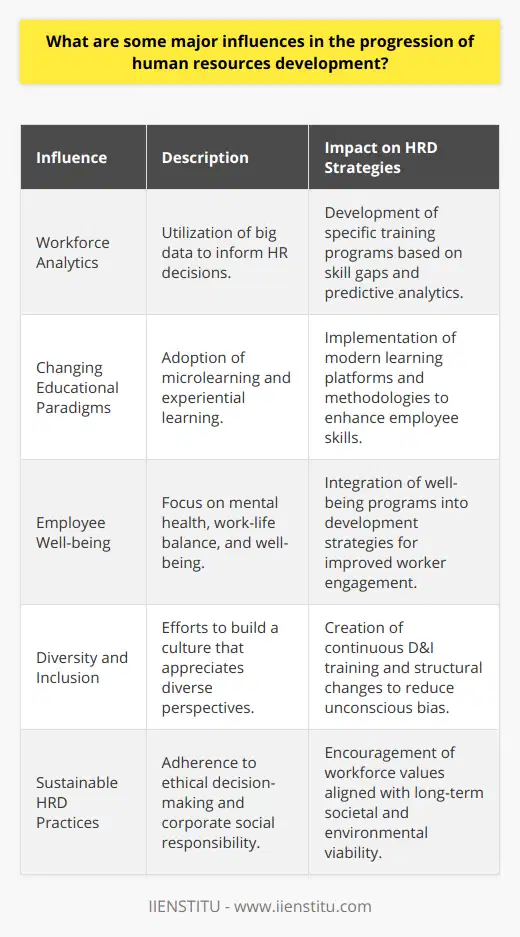
What factors led to the emergence of human resources development?
Industrial Revolution's Influence
The emergence of human resource development owes much to the Industrial Revolution. Previously, training and development mainly focused on skills related to specific trades.
Evolution of Economic Systems
The transition from feudal to industrial economies created the need for more structured and systematic training, necessitating the incorporation of human resource development practices. Effective work organization necessitated skills training and a careful allocation of manpower.
The Importance of Social Movements
Furthermore, social movements significantly influenced this process. Specifically, the workers' rights movements led to the adoption of fair labor practices and inclusive policies, shaping practices that form part of modern human resource development.
Psychology's Contribution to HRD
Additionally, the advent of industrial psychology contributed to understanding human behavior at work. This discipline provided insights into employee motivation, performance improvement, and organizational culture, central elements to human resource development today.
The Role of Government Legislation
Lastly, government legislation significantly shaped human resource development. Laws ensured occupational safety, health standards, fair compensation, and non-discrimination, which necessitated the establishment of frameworks for employee rights, training, and benefits.
The Emergence of Technology
With the advent of technology, there was a need for employee upskilling and reskilling to stay competitive. This trend continues today, with technology continuously changing the landscape of labor skills and training needs.
In conclusion, multiple factors drove the evolution of human resource development. Broadly, these include economic developments, social movements, psychology, government legislation, and technology. These have all altered the nature of work and the way we organize, train, and develop human resources.
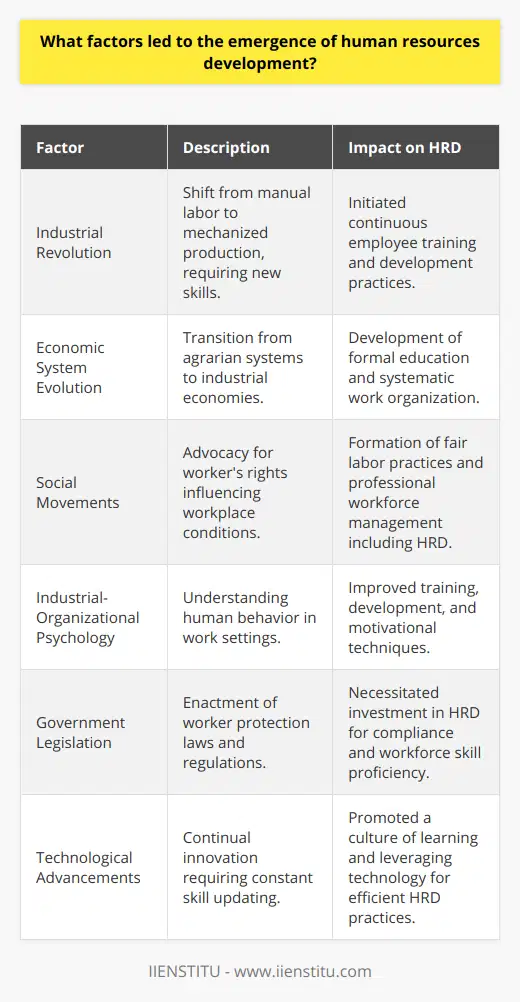
How did industrial revolution impact the evolution of human resources management?
Impact on Job Design
The industrial revolution significantly impacted human resource management, particularly in the aspect of job design. It marked the shift from craftsmanship to machine-based manufacturing. This change prompted the creation of jobs that focused on operating machines.
Introduction of Wages System
Industrial revolution ushered in the wage system. Employers offered remunerations based on the hours employees worked. This development necessitated keeping track of workers' hours and pay. It gave birth to payroll management, a critical component of human resource management.
Need for Worker's Rights
The revolution provoked the question of workers' rights. With the introduction of machines, working conditions declined. Cases of injuries and deaths compelled employers to consider workers' safety. Human resource management responded by integrating safety regulations into the work environment.
Development of Labour Laws
As industrialization continued, the issue of exploitation arose, leading to the creation of labour laws. Business owners realized the necessity to manage their workforce better. Today, human resource managers ensure compliance with these laws to maintain harmonious working environments.
Emergence of Training and Development
Lastly, the revolution impacted employee training and development. With the introduction of new machinery, workers needed to acquire fresh skills. This resulted in the emergence of training and development programs, a vital aspect of modern human resource management.
In conclusion, the industrial revolution marked a turning point in human resource management. It prompted pivotal changes, shaping HRM into what we recognize today. Through every stage of industrialization, HRM evolved, adapting to the changing needs of the workforce and workplace.

What historical events significantly influenced human resources development practices?
Historical Events Influence on HR Practices
Labor Force Shift Post World War II
Post World War II, significant demographic shifts contributed to crucial changes in human resources (HR) practices. A surge in the labor force accelerated the need for organized personnel management, equipping HR with a strategic function in the organizational structure.
Civil Rights Movement and Legislation
The Civil Rights Movement in the 1960s profoundly influenced HR development practices. The Civil Rights Act, 1964, mandated employers to treat their staff without any discrimination. It forged the path towards equal employment opportunity and affirmative action policies, necessitating HR professionals to assure compliance within their organizations.
Women's Liberation Movement
This movement during the 1960s and 1970s amplified the role of women in the workforce. HR needed to reevaluate its practices and policies to accommodate the rising need for gender equality, maternity leaves, and flexible working hours, among other things.
Technological Revolution
The advent of technology, particularly during the late 20th century, dramatically reshaped the HR landscape. Companies started exploiting the potentials of digital platforms and HR software to streamline their HR practices, such as talent acquisition, performance management, and employee engagement. It also incurred a pressing need to retrain and reskill the workforce, especially in terms of digital literacy.
Globalization and Economic Liberalization
The era of globalization and economic liberalization during the late 20th century made organizations more multinational. HR had to deal with various cross-cultural and geopolitical issues, such as talent mobility, outsourcing, and legal complexities. This obliged HR to become more agile, adaptive, and strategic in its approach.
In summary, several historical events have shaped the HR practices we see today. These significant events brought about changes that heightened the HR role to a strategic partner in the organization. It is evident that HR will continue to evolve as new historical events unfold, challenging its traditional operations while presenting fresh opportunities for human capital development.
